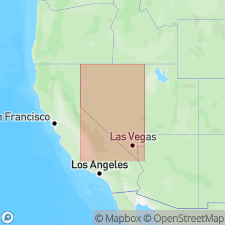
- Usage in publication:
-
- Mullen Formation
- Modifications:
-
- Named
- Dominant lithology:
-
- Tuff
- Latite
- Perlite
- Pumice
- Sandstone
- Conglomerate
- Breccia
- AAPG geologic province:
-
- Southern Oregon basin
Summary:
Mullen Formation. Divided into three major units (descending): (1) columnar-jointed latite ash-flow tuff, flow-banded vitrophyre, collapsed pumice altered to perlite; (2) buff coarse-grained, poorly indurated dacite tuff, tuffaceous sandstone, conglomerate; and (3) dark-gray to black latite, tuff breccia with collapsed black pumice at its base (McJannet, 1957; Wallace, 1975). Welded ash-flow tuffs of the Mullen not yet conclusively recognized outside type area. Total thickness at type is 128 m. Unconformably overlies middle Miocene (14 Ma) Chloropagus Formation. Unconformably underlies Pleistocene (100 ka) Lake Lahontan beds, olivine basalt flow, poorly sorted, weakly consolidated sands. Age is middle Miocene (12.7 Ma) based on date of basal ash-flow unit. Report includes geologic map and fossil lists.
Type area: northwest-trending mesa in group of mesas north of Mullen Pass, in secs. 2, 3, 34, and 35, T. 23 and 24 N., R. 21 E., Washoe Co., western NV. Named from Mullen Pass.
Source: Modified from GNU records (USGS DDS-6; Denver GNULEX).
For more information, please contact Nancy Stamm, Geologic Names Committee Secretary.
Asterisk (*) indicates published by U.S. Geological Survey authors.
"No current usage" (†) implies that a name has been abandoned or has fallen into disuse. Former usage and, if known, replacement name given in parentheses ( ).
Slash (/) indicates name conflicts with nomenclatural guidelines (CSN, 1933; ACSN, 1961, 1970; NACSN, 1983, 2005, 2021). May be explained within brackets ([ ]).

